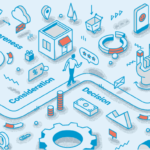Last year, 59 percent of consumers started their holiday shopping before Thanksgiving, a nearly 20-point increase over 2019. In 2021, with news about supply chain backlogs in the headlines, 57 percent of shoppers say they plan to begin making holiday purchases even earlier during September and October. Bolstered by increasing consumer confidence, the longer selling season comes with projections of an up to 9 percent increase in total sales. But, for retailers, this holiday season also comes with unique inventory management challenges and rapidly evolving shopping trends.
Preparing for the challenges and opportunities in today’s highly competitive and uncertain market requires a careful balance between navigating obstacles and staying ahead of shifting trends. Here’s an up-to-the-minute checklist to help retailers prepare.
Optimize your inventory management.
Supply chains are being disrupted by shortages, shipping container and trucking challenges, and the resulting rate hikes. Retail logistics experts point to global supply chain pressures that are resulting in about 40 percent of shipping vessels arriving on time compared to an 80 percent on-time arrival rate last year. The situation makes inventory planning, forecasting, and automation more important than ever for keeping shelves stocked and sales transactions flowing.
Centralized inventory management through your point-of-sale (POS) system is business-critical. By integrating your inventory management across sales channels, including e-commerce and multiple store locations, your POS system provides an all-in view to guide forecasting, minimize out-of-stock scenarios, and reduce the risk of having too much capital tied up in inventory. It also captures and reports the historical data points and insights to map out the inventory you’ll need – and exactly when you’ll need it — throughout the holiday shopping season.
In addition to providing real-time inventory tracking of exactly what’s in stock, what’s selling well, and what’s not, centralized inventory management also provides you with automation options to simplify re-ordering processes and significantly reduce out-of-stock situations. For example, based on product-specific – and even seasonal-specific – inventory thresholds, you can automatically initiate the re-order process with trusted vendor partners from within your inventory management system, saving you time and money.
Related: 3 Secrets Behind Effective Inventory Management
Create cross-channel ease.
Usage and comfort levels for online shopping accelerated during the pandemic. Today, 44 percent of consumers report shopping online regularly, compared to just 9 percent pre-pandemic. However, this doesn’t mean that e-commerce is replacing in-store shopping. When they have a choice, 46 percent of consumers prefer in-person shopping over virtual.
What’s different today is that consumers no longer perceive online and offline shopping as an either/or decision. Instead, customers expect retailers to provide seamless experiences that combine brick-and-mortar, e-commerce, and mobile options. For example, a customer may browse products on their smartphone, compare options and check in-stock availability online, and then visit the store to try out the product before purchasing. Another customer may opt to browse in-store and then go to the store’s e-commerce site later to make the purchase. Behind the different interactions, an integrated POS system ensures consistent information, personalized customer experiences based on purchase history and loyalty program status, and smooth point-of-sale purchase transactions.
For retailers, providing an integrated, omnichannel experience pays off. Shoppers who interact with a retailer through physical, online, and mobile channels have a 30 percent higher customer lifetime value compared to those who only interact through a single channel.
Related: Omnichannel Retail: The POS Essentials That Make It Possible
Ramp up convenience.
Convenience always counts for customers, but it can be an even bigger differentiator during the busy holiday season. One of the hottest trends in retail convenience is the option to buy online, pick up in-store, also known as BOPIS. Eighty percent of consumers have purchased online and then picked up the items in-store or curbside – and one in three say it’s their preferred shopping method.
BOPIS gives customers the flexibility to connect their online and offline shopping experiences by browsing and buying items online while maintaining the immediacy of picking up their purchases right away. A related service that’s gaining popularity is ROPIS (Reserve online, pickup in-store), which provides an option for customers who want to ensure the item they want is in stock but prefer to pay in-person.
An integrated POS system makes offering BOPIS or ROPIS easier because it brings your e-commerce and in-store channels together. In addition, mobile POS can further enhance the BOPIS experience for your customers. Mobile capabilities make your POS system available to associates via a tablet or phone, so they can easily look up, fulfill a customer’s order, and process payments from anywhere in the store – or even curbside! Plus, BOPIS convenience drives revenues for retailers. Eighty-five percent of shoppers report buying additional items when they visit the store to pick up their purchases.
The holiday season represents up to 20 to 30 percent of annual revenues for most retailers. POSIM is a point-of-sale and inventory management system that’s designed to help you make the most of your data, streamline processes, and enhance customer shopping experiences. Contact us for a demo and discover what’s possible with POSIM.












